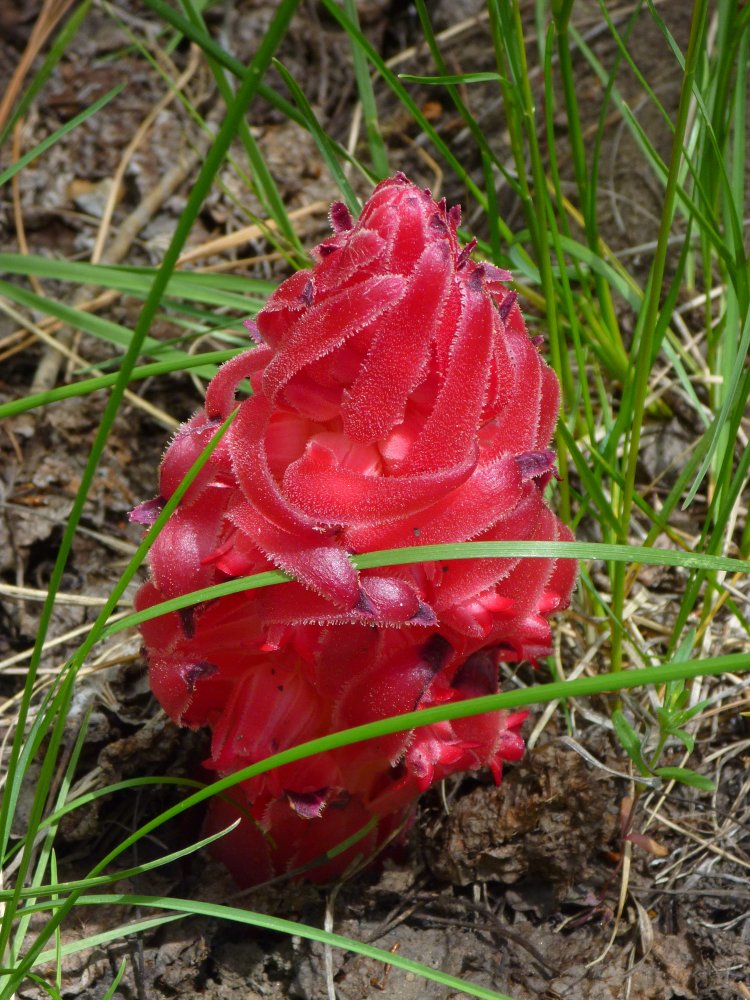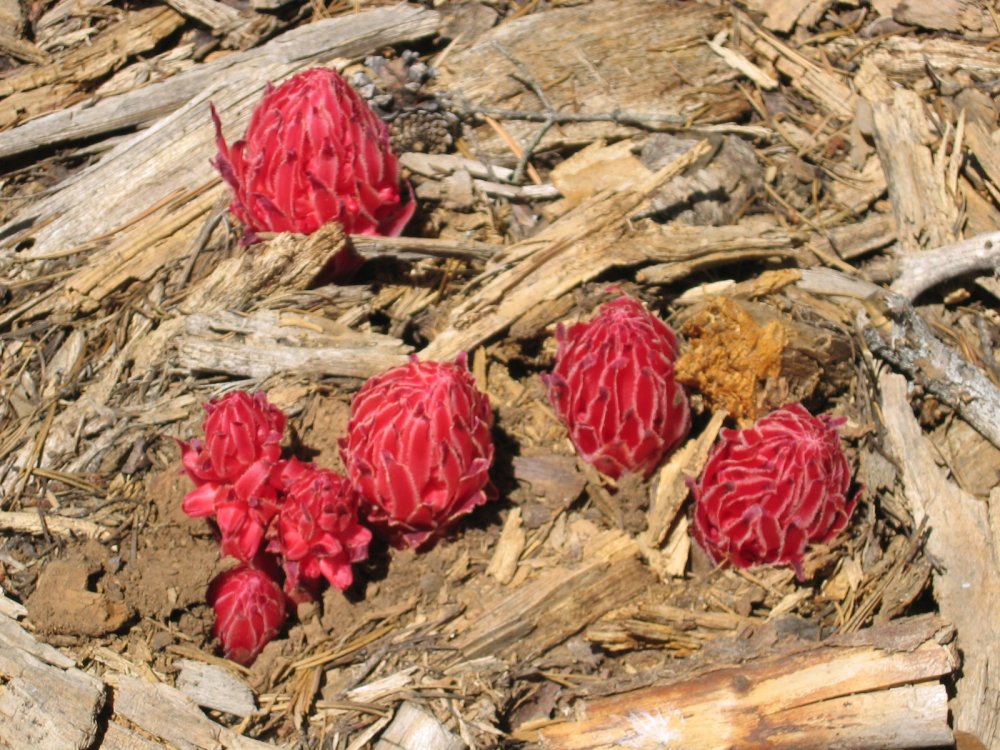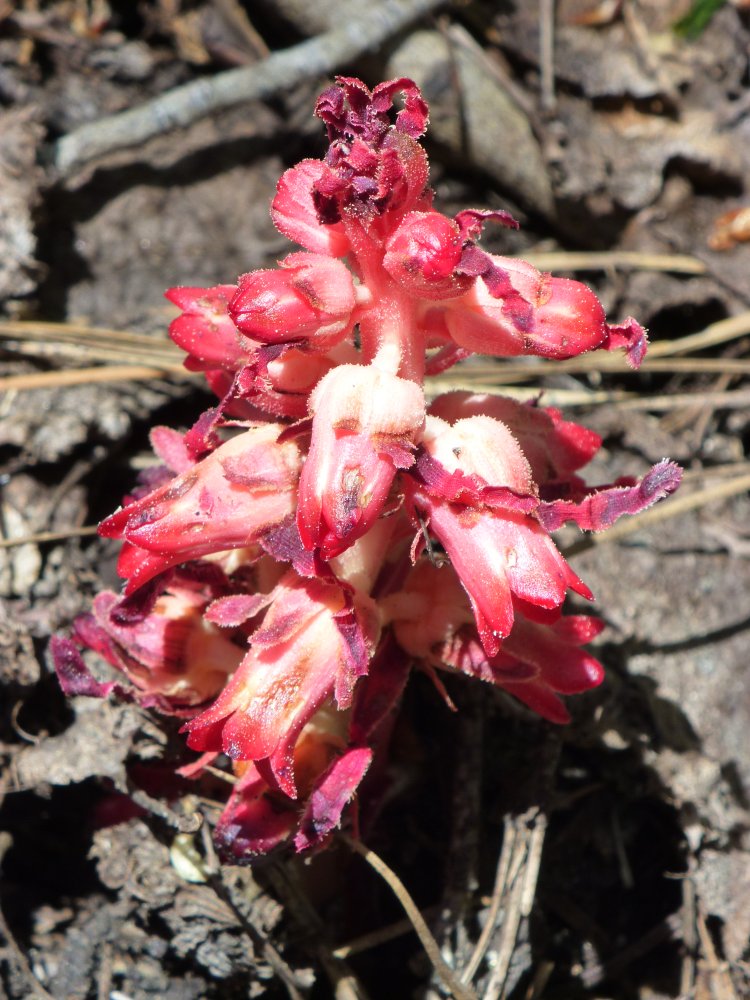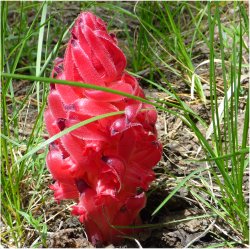
Snow plant with red scales in the
Mt. Rose Wilderness near Reno, June 2010
As their name indicates, snow plants
(Sarcodes sanguinea) break through the forest floor
when the last patches of snow are melting away in spring.
These plants of the heath family are found in shaded locations
of alpine habitats; for example, at mid-level and higher
elevations of the Sierra Nevada. Snow plants do not have green
leaves. They are easily spotted due to their blood-red scales
and tubular flowers on a sticky, clammy, red stalk. They
grow—often
in clusters—in humus of coniferous forests [1-3].
The Field Guide to Wildflowers of the Western Region
contains the comment:
“Once seen, this plant is never forgotten; the brilliant
red is startling in the filtered sunlight against the dark
background of the forest. ”
(Richard Spellenberg, 2001 [3]).
Verna R. Johnston fittingly summarizes the snow-plant ecology in
her Sierra Nevada Naturalist's Companion:

Cluster of snow plants near
Brockway Summit
between Lake Tahoe and Truckee
in May 2007
“Its stout fleshy stems, covered with reddish scales
and crowded with bell shaped crimson flowers, push through
the humus just after the snow has melted. Sometimes there are
two stems to a clump, occasionally as many as twenty-two.
Lacking green leaves, the snow plant cannot manufacture its
own food as plants with chlorophyll do. It feeds indirectly
on decayed organic matter in the soil through the medium of
a microscopic fungus that completely covers its roots. The
plant and the fungus share a symbiotic relationship known as
mycorrhizal. As spring wanes snow plant flowers produce small
red marblelike capsules. By September the parent has one or
more well-forming young plants underground at its base, ready
to emerge next spring at the first sign of melt. ”
(Johnston, V. R., 1998 [4]).
The cited text highlights the snow plant's existence as a
saprophyte, living on dead organic
matter and fungi. The symbiotic relationship is tripartite,
since snow plants rely on fungi as well as neighboring trees
from which they obtain their fixed carbon [5]:
Sarcodes sanguinea is a
nonphotosynthetic mycoheterotrophic
plant of the Ericaceae-subfamily
Monotropoideae. Snow plant distribution
is restricted to the mountains of the Sierra San Pedro
Mártir of Baja California and mountain ranges of
California and southern Oregon.
The world-wide diversity of
saprophytic plants includes various
Californian species such as the featured snow plant as well as
pinedrop, pinesap, sugar stick, gnome plant, Indian pipe and
California pinefoot. Snow plants are also found in limited areas
of northwest Nevada: the fir and pine stands of the Mt. Rose
Wilderness between Reno/Sparks and Lake Tahoe are a good place
to look.

Snow plant with tubular bells
in the Mt. Rose Wilderness
near Reno, June 2010
The scientific name Sarcodes sanguinea is derived from
the Greek compositum Sarcodes, meaning
“flesh-like” (sarx for “flesh” and
oeides for “like”; see
calflora.net) and the Latin adjective sanguineus, meaning blood-red (see calflora.net).
The common name of Sarcodes sanguinea is found to be written in one or two words: “snowplant” or “snow plant,” respectively. The name “snowflower” is used synonymously (for example, see gnolls.org)
The snow plant is a beautiful and fascinating plant species, which
I have chosen as the logo flower of my Twitter traveling &
recreation microblog
Traveling Ahead
(@TravelingAhead).
|
References
| [1] |
Laird R. Blackwell:
Tahoe Wildflowers.
Morris Book Publishing, LLC,
Falcon Guide, Guilford,
Connecticut,
2007, page 47.
|
| [2] |
Peter Alden and Fred Heath:
Field Guide to California.
Chanticleer Press, Inc.,
New York,
1998, page 32.
|
| [3] |
Richard Spellenberg:
Northern American Wildflowers,
Western Region.
Alfred A. Knopf, Inc.,
New York,
2001, page 618.
|
| [4] |
Verna R. Johnston:
Sierra Nevada, The
Naturalist's Companion. Revised Edition
University of
California Press,
Berkeley and
Los Angeles,
1998, page 87.
|
| [5] |
M. I. Bibartondo,
A. M. Kretzer, E. M. Pine and T. D. Bruns:
High root concentration and
uneven ectomycorrhizal diversity near
Sarcodes sanguinea (Ericaceae): A cheater that
stimulates its victims?
American Journal of Botany
2000,
87
(12),
pp. 1783-1788.
|
|
|
|






